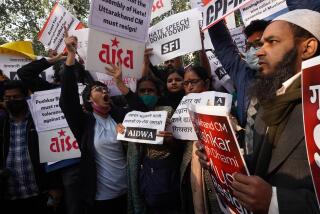COLUMN ONE : Lynchings Over Caste Stir India : The deaths of young lovers from different classes raise questions of law, justice and power in a nation where tradition and progress contend.
MEHRANA, India — It was at the entrance to this little village of mud and brick, beside an ancient shrine to Lord Shiva the destroyer, that Mehrana’s star-crossed young lovers recently ended their lives side by side.
From a sturdy limb of Mehrana’s holy banyan tree, Roshni, 16, and Bijendra, 20, were hanged just after 8 a.m. for all the village to see, a symbol of order, the elders had said, of tradition and of the village’s izzat --chastity and honor.
The young woman, Roshni, was a high-caste Hindu, after all, one of the Jats who own the land, the village and power over the likes of Bijendra and his fellow Jatavs. Bijendra, with whom Roshni had eloped three days before, was from a “backward” caste, traditionally so impure and inferior that they became known as Hinduism’s Untouchables.
So separate are the Jats and Jatavs--not unlike Shakespeare’s Montagues and Capulets, only centuries older and with a feud far more stubborn--that each has its own well in Mehrana. The Jats live on one side in houses of stone and tile, the Jatavs on the other in huts of mud and straw. Their separate realities intersect only when the Jats need a Jatav to pick a crop, build a house or mend a shoe.
For both sides, Roshni’s and Bijendra’s was a love impure.
They had to die. With that, even Roshni’s father, Ganga Ram, agreed.
“For me,” the Jat elder had said at the nightlong meeting in the village square that condemned the couple to hang March 27, “the girl is dead already.”
And so he helped string up his daughter, her lover and the couple’s best friend from the centuries-old banyan tree. But even after three strong tugs on the rope, Roshni and Bijendra refused to die. So the Jats gathered a heap of dry wood, then dragged the young couple, writhing in pain, to the makeshift funeral pyre they had built nearby. And in a final ritual of ancient village justice, the elders burned them to death, Jat and Jatav together, so that none would forget this day.
A single Jatav escaped the village, dodging armed Jat sentries posted all around Mehrana. It was Amichand, the uncle of Bijendra’s best friend, who reported every detail to the nearest police station, 10 miles away.
Now Mehrana’s modern-day Romeo and Juliet have become a symbol of a far different sort for India, a grisly illustration of the magnitude of the forces defying its march into the modern age--forces increasingly outstripping logic and the rule of law as the divisions in its society grow ever deeper.
Decades after India’s caste system was constitutionally banned, the lynching of the lovers in Mehrana triggered an outcry from Indian liberals and intellectuals in the nation’s capital. The newspaper Indian Express condemned it as “savagery at its appalling worst” in an editorial headlined “Monstrous!”
“What has the modern Indian state done to prevent these monstrous triumphs of kangaroo justice?” the newspaper asked, concluding, “What is necessary is not more speeches and promises, but arrest and punishment of the guilty.”
Under unprecedented popular pressure, the politicians and police ordered the arrest of 37 Jat elders who approved and carried out the lynching; 21 of them are now in jail.
But in deeply polarized India--poised on the brink of yet another bloody national election, in which the ancient caste system already is a prominent issue--the Mehrana village elders who ordered the hangings have drawn an unprecedented number of defenders, as well.
One state government minister paying a condolence visit to the village, for example, lavished his greatest gift not on the Jatavs, but on the Jat mother of Roshni--a pledge to free her husband from jail within days so he can supervise the spring harvest.
And in a politically paralyzed country where three national governments have come and gone in 18 months and where the institutions of government and its bureaucracy have all but ceased to function at the grass-roots in many regions, defenders of the elders of Mehrana say they are to be commended for keeping a semblance of order in a village that seems centuries removed from the ideal of a modern Indian state.
In reality, Mehrana is just 70 miles south of the capital, New Delhi. It is three hours away, a drive that peels back time and ends in a bumpy ride through rocks, dust and wheat fields.
The Jatavs were out for the harvest this week, plucking the golden sheaves by hand for their Jat masters, even after most had been jailed or had fled to distant villages to escape arrest.
Inside the divided village of 3,000 or so, accounts of the tragic saga of Roshni and Bijendra varied wildly. (Most villagers denied having watched the lynching, although police say nearly everyone did.)
Detectives say that behind the ritual killings was a disbelief in both communities that what occurred between Roshni and her lover could ever have happened between members of two groups who refuse to even touch each other.
“My girl was kidnaped by these Jatavs,” Bishan Devi, the mother, shouted angrily to visitors. “Everything was forced. First, the Jatavs took away my daughter, fed her liquor and took her in a hayloft. And then the Jats found her there, locked her in our house, threatening to break our bones if we let her out and finally took her away and killed her. . . .
“I would never have married her to the Jatav boy,” she said. “She was a good girl. Four months ago, she was engaged to Ramesh, a boy from another village. On April 8, she was to marry.”
Asked whether Ramesh is a Jat or a Jatav, a look of horror washed over her face. She was furious. “What are you saying?” she screamed. “Of course he is a Jat. How could you even ask such a thing of me. Now leave this house!”
On the Jatav side of the village, a similar wave of shock swept across the face of Sarawati, the mother of Bijendra. After several minutes of wailing, “My son! My child! My little boy!” she wiped her tears. And as she sat cross-legged in the mud wearing shreds of a shirt held together by a single safety pin and loose stitches, she explained that a love affair between her boy and the Jat girl was, well, simply impossible.
It was another boy, a Jat boy named Shyam, who had eloped with Roshni, she explained. Indeed, the police confirmed that Roshni had eloped with a Jat boy named Shyam but that it took place nearly two years ago.
“She was a whore,” Sarawati said of her son’s lover. “Never could this have happened.”
But several yards away, at the house of Bijendra’s best friend, Ram Kishan, relatives told another story. Ram Kishan’s mother confirmed that “Bijendra and Roshni were lovers,” who were aided in their elopement by her son.
It was the village’s most powerful elder, a wealthy Jat named Mangtu, who convened the village panchayat (traditional council) at the request of Roshni’s family. “Papu, a brother of Roshni, insisted that these people should be hanged, otherwise he was going to hang himself,” the mother said.
It is from the official statement of Amichand, Ram Kishan’s uncle who escaped within minutes of the hanging, that police say they have gotten the most detailed account of what happened after the young couple returned from a three-day absence from the village and announced their desire to marry.
At the insistence of village elder Mangtu, the panchayat convened in a 25-foot-square dirt meeting place in the village at 9 p.m. on March 26. There were 37 of them, all Jats.
“The whole night, the panchayat was on,” he recalled. “And throughout the night, Mangtu and the others beat Bijendra and Ram Kishan by turns. Then, they were hanged upside down by their feet. They soaked their private parts in kerosene and burned them. . . .
“At 5 a.m., the Jatavs were called to the panchayat, and they were asked about their opinion (of hanging the accused). They were all scared, so they accepted the decision by consensus. At that time, Mangtu and the others formally accused Ram Kishan and Bijendra of eloping with this girl, and they decided to hang the two boys and the girl.
“They were brought to the banyan tree, and then the fathers were summoned, and the Jats demanded that the fathers hang their own children. When they protested, they beat them up. At that point, the mothers were summoned, and they also were beaten.
“After that, the fathers of the children were forced to hang them. Then, they were taken down. They only appeared to be dead. They were dragged to the cremation ground, where . . . they were forcibly cremated.”
To stop the Jatavs from leaving to report the crime, the Jats surrounded the village. But Amichand told police: “I sneaked out to give you this report. Please take action on it.”
The police did act swiftly. Vijay Kumar Gupta, the police superintendent for the district who is based in Mathura, 40 miles away, boasted that he personally arrived on the scene at 12:30 p.m., just four hours after the lynchings.
Although Gupta now insists that the crime was not committed purely because of caste, calling it “a multi-causal phenomenon,” his own police report blames caste for the killings. Most analysts insist that the police were aggressive in publicizing the case and acting on it because of the Indian national elections, now scheduled for late May.
Among the key issues in the campaign is a controversial quota system, which reserves university slots and government jobs for low-caste Hindus like the Jatavs. High-caste leaders such as the Jats have condemned the new system as reverse discrimination.
When the new law was first proposed eight months ago, it triggered a nationwide wave of teen-age suicides by protesting high-caste youths.
Ever since, Mehrana’s state of Uttar Pradesh, a populous and vote-rich area where most of the villages remain physically and socially divided along caste lines, has become a flash point for the caste dispute. So it was little wonder that the state’s powerful chief minister, Mulayam Singh Yadav, dispatched his minister of religion and sports to Mehrana recently as a gesture to maintain support of both Jats and Jatavs.
But as the minister, Sardar Singh, worked his way through the village’s narrow lanes, it was clear that he was more attentive to Jats than to Jatavs. Although Singh is a high-caste Hindu, it was only in the Jatavs’ mud enclave that a deeper reason became clear.
When asked how their village’s love-and-murder drama is likely to affect their vote next month, Jatavs gathered outside Bijendra’s tiny hovel fell silent and looked blankly at one another.
Finally, Bijendra’s sister, Kesar, spoke. Shaking her head beneath a soiled green scarf, she said quietly: “The vote? Well, we are always forced to vote. Whoever forces us, that is who we vote for. And it has always been the Jats who force us. So that is how we will vote.”
More to Read
Sign up for Essential California
The most important California stories and recommendations in your inbox every morning.
You may occasionally receive promotional content from the Los Angeles Times.










